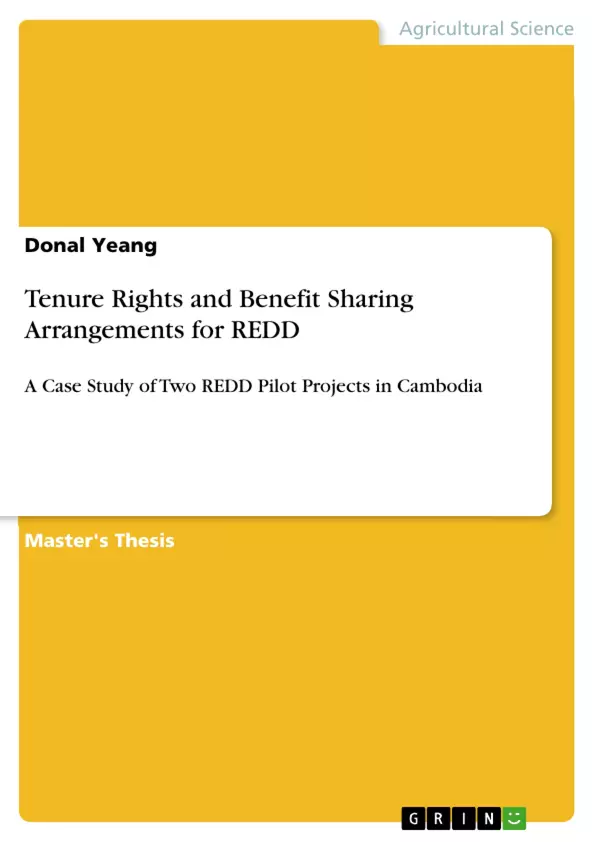Deforestation and forest degradation account for up to 20% of the total annual anthropogenic greenhouse gas emissions. As a result, current approaches to address climate change include strategies to reduce deforestation and forest degradation in developing countries (REDD). Even though REDD is still under discussion within the UNFCCC framework, many REDD pilot projects are being implemented across the tropics. Securing local communities’ tenure rights and their equitable access to forest conservation benefits are critical in REDD because local communities could be excluded from REDD benefits if their land and forest access rights are not adequately addressed. In Cambodia, two REDD pilot projects: Community Forestry Carbon Offset Project (CFCOP) in Oddar Meanchey province and the Seima Protection Forest Project (SPF) in Mundulkiri province, are being implemented. This study aims to contribute to the development of an effective REDD mechanism in Cambodia by examining land and forest tenures and benefit sharing arrangements under the two REDD pilot projects in Cambodia. The paper employs concepts of discourse coalitions and rules of the game to explain tenure rights and benefit sharing arrangements in the two projects. The study is based on literature review, analysis of key text documents and interviews with 19 respondents from government, civil society, donor community, community and private sector involved in the two REDD pilot projects and from outside. Results show that the two REDD pilot projects are being implemented in community forests and protection forests. In both projects, local communities are granted forest access rights. In addition, the projects have legitimized tenure rights of local communities in the project areas as provided for through the Land and Forestry Law in Cambodia. The study also indicates that revenues from carbon credits generated by the projects will be shared with the local communities. According to the Government Decision No.699, more than 50% of net revenues will be channeled to local communities in the CFCOP while the sharing of the revenues in the SPF is still under consideration. The study offers lessons that could guide other REDD projects in securing local communities’ forest access rights and their rights to benefits from forest conservation.
Inhaltsverzeichnis (Table of Contents)
- Summary
- Acknowledgement
- 1 Introduction
- 1.1 Background
- 1.2 Problem Statement
- 1.3 Objectives
- 1.4 Research Questions
- 1.5 Scope and Limitations
- 1.6 Structure of the Study
- 2 REDD and Tenure Rights
- 2.1 REDD and Tenure Rights: A Global Perspective
- 2.2 REDD and Tenure Rights in Cambodia
- 3 Frameworks for Analyzing REDD and Tenure Rights
- 3.1 Discourse Coalitions
- 3.2 Rules of the Game
- 4 Methodology
- 4.1 Study Area
- 4.2 Data Collection
- 4.3 Data Analysis
- 5 Results and Discussions
- 5.1 Forest Tenure Regimes in Cambodia
- 5.2 Land and Forest Tenure in the CFCOP
- 5.3 Land and Forest Tenure in the SPF
- 5.4 Benefit Sharing Arrangements in the CFCOP
- 5.5 Benefit Sharing Arrangements in the SPF
- 6 Conclusions
- 7 Recommendations
- References
Zielsetzung und Themenschwerpunkte (Objectives and Key Themes)
This study aims to contribute to the development of an effective REDD mechanism in Cambodia by examining land and forest tenures and benefit sharing arrangements under two REDD pilot projects. The research utilizes the frameworks of discourse coalitions and rules of the game to analyze the complexities of tenure rights and benefit sharing in these projects. The study's objectives are to investigate the existing forest tenure regimes in Cambodia, analyze the specific land and forest tenure arrangements within the two REDD pilot projects, and evaluate the benefit sharing mechanisms employed in each project.
- REDD and Tenure Rights
- Benefit Sharing Mechanisms
- Local Community Participation in REDD
- Discourse Coalitions and Rules of the Game
- Forest Tenure Regimes in Cambodia
Zusammenfassung der Kapitel (Chapter Summaries)
The first chapter provides a comprehensive introduction to the study, highlighting the importance of REDD and the challenges associated with securing tenure rights and equitable benefit sharing for local communities. Chapter 2 delves into the global context of REDD and tenure rights, followed by a specific analysis of the situation in Cambodia. Chapter 3 introduces the theoretical frameworks of discourse coalitions and rules of the game, providing a lens for understanding the complexities of REDD and tenure rights.
Chapter 4 details the methodology employed in the research, including the study area, data collection methods, and data analysis techniques. Chapter 5 presents the key findings of the study, focusing on the existing forest tenure regimes in Cambodia, the land and forest tenure arrangements within the two REDD pilot projects, and the benefit sharing arrangements in each project. This chapter also discusses the implications of these findings for the effectiveness of REDD implementation in Cambodia.
Schlüsselwörter (Keywords)
The study focuses on REDD, tenure rights, benefit sharing, Community Forestry Carbon Offset Project (CFCOP), Seima Protection Forest Project (SPF), discourse coalitions, rules of the game, and forest tenure regimes in Cambodia. This research explores the complex interplay between these key concepts and their implications for successful REDD implementation.
- Arbeit zitieren
- Donal Yeang (Autor:in), 2010, Tenure Rights and Benefit Sharing Arrangements for REDD, München, GRIN Verlag, https://www.grin.com/document/156550



